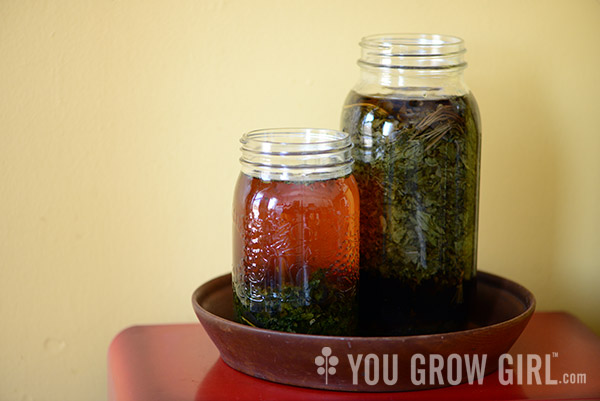
The other day I was doing a spring cleaning of my kitchen. I have to pause here and laugh about my use of the word spring since while we are technically past the equinox, the current weather conditions (negative daytime temperatures and snow cover) are very un-spring-like.
Anyways, while deep cleaning some shelves I came upon a few containers of very old dried herbs that I had completely forgotten about. Many of these herbs were grown and dried nearly 10 years ago and were wildly out-of-date. I grow and dry A LOT of herbs every year and have no reason to hold onto anything that is more than a year old. Sorting through the packages, I noticed herbs such as nettles, dill, sage, plantain, and mint that while old and lacking flavor and/or medicinal potency, could still see some use as a valuable springtime tonic for my houseplants.
Plants, even those that we consider culinary rather than medicinal, are not benign. They all contain nutrients and minerals, and many can serve functions as pest repellents or beneficial tonics for our gardens. This practice goes beyond compost or the simple recycling of nutrients back into the garden. This is more intentional and is about brewing herbs into a tea and using them to benefit the health of other plants much in the way that we would apply them to ourselves.
A tonic like this can be used on houseplants and outdoor potted plants that need a boost as well as young seedlings, and to help newly planted transplants get established outdoors.
How to Make Herbal Tonic for Indoor Use
During the growing season I make an outdoor brew using fresh foliage that ferments into a stinky and messy concoction. For indoor use I prefer to stick to a simple brewing method to avoid noxious smells.
Dump a bunch of herbs into a large Mason jar and cover with hot water. Allow it to sit for some time and then strain and toss the plant matter into the compost or sprinkle right onto the surface of your garden’s soil at the base of plants that you think could benefit from a little boost. Use the liquid as a concentrate by adding it to the watering can. When it comes to houseplants I suggest waiting until spring when the days are longer, brighter and the plants are showing signs of new growth before applying the tonic. Applying to plants in winter tends to encourage a growth spurt when there isn’t enough sun to support it. You can end up with thin and unhealthy new growth that will only encourage pests such as aphids to swoop in and take advantage.
Alternatively, wrap the herbs into a piece of cheesecloth, secure with a string, and toss the bundle into a watering can of room temperature water. The bundle can sit in there indefinitely and eventually be tossed into the compost when there is nothing left to give.
Herbs to Use
Stinging nettles, dill, chamomile, dandelion, plantain, sorrel, shiso, tansy, yarrow, watercress, parsley, sage, and comfrey are just a few common herbs that contain varying degrees of different nutrients and trace minerals that are beneficial to growing plants.
Related Info
I’ve written about making your own plant-based fertilizer tea here on the site and in greater detail in my book Easy Growing (see page 46). In my first book, You Grow Girl, there is a recipe for Herbal Tea on page 94. There is also a recipe for an insect repellent spray using herbs such as yarrow, tansy, thyme, lavender, etc on page 105.
I am going to use this suggestion thanks.
When you say “allow to sit for some time” do you mean a couple of days? Or a couple of hours? I definitely have dried herbs past their best that need to brew.
I left it open-ended because it can be any length of time. Steeping longer will release more, but it can also lead to stinking… when I do this outside in the growing season I allow it to ferment and break down more because the smell doesn’t matter so much. But since I wrote this for indoor use, half a day or so is fine.
I just had a “well, duh!” moment! It has never occurred to me to use my old dried herbs as a tea for plants. Thank you for jogging my brain, and of course, for sharing. Have a gorgeous day!
An excellent idea! I like the gleaming glass jars in your photo. I am a sucker for “vessels” of every shape and size.
Our ‘spring’ has arrived and left several times, with snow flurries most of the day April 9th. I found myself cleaning spaces that had not been attended to in quite some time. This was a second choice activity, as I tried to distract myself from thinking of all I wanted to work on outside and could not. Soon….. weather will break and everything will wake up all at once!
Never tried it before. I’ve brewed compost tea before, but this seems very simple to do.
Thanks for the tip.
Javi
Thanks for the cool advice! I never considered using herbal tea to repel pests in the garden and make my plants grow better and stronger. I will definitely try it, since we have many herbs in our home which are just sitting there for years. I’ve used some natural fertilizers like fish meal, but I never tried to make one by myself. Thanks for sharing!